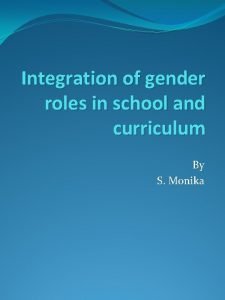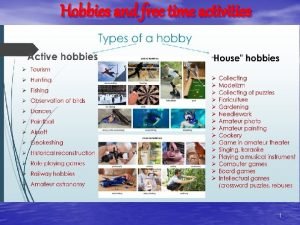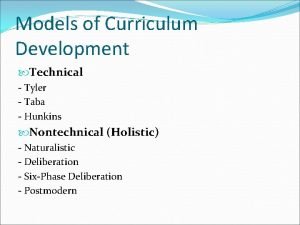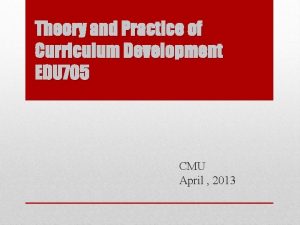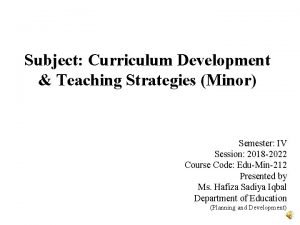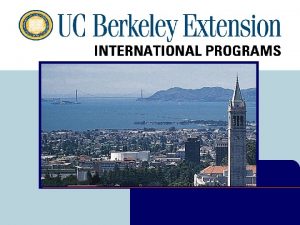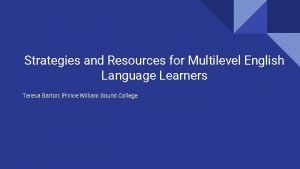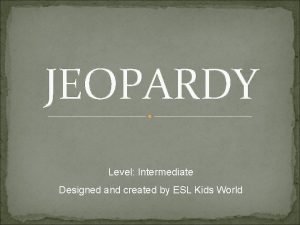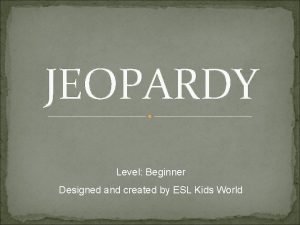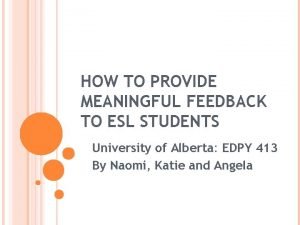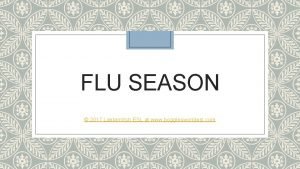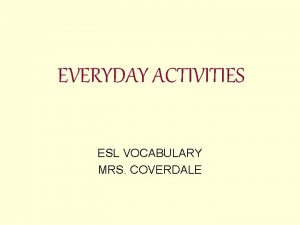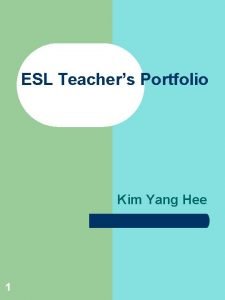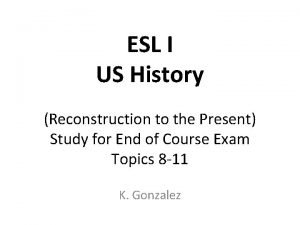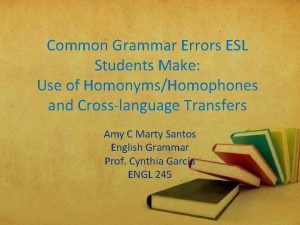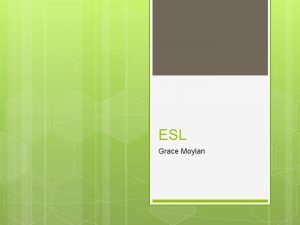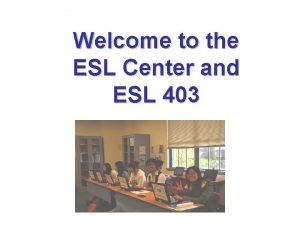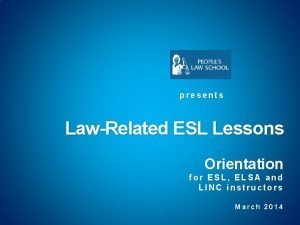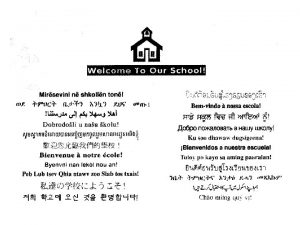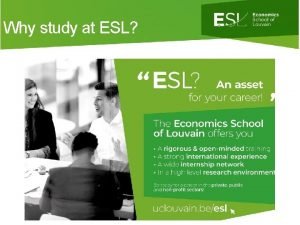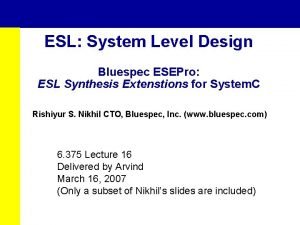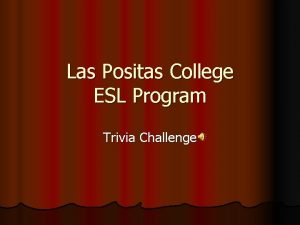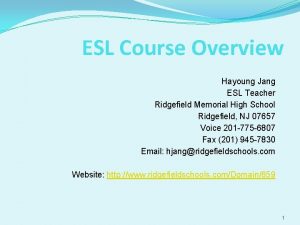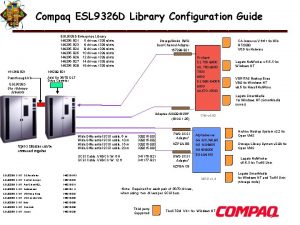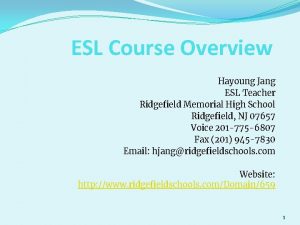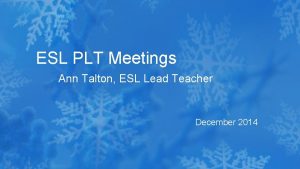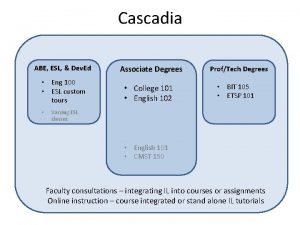lecture 5 Curriculum Development in ESL Roles and


















- Slides: 18

lecture 5: Curriculum Development in ESL: Roles and Responsibilities Dr. Douglas Fleming Faculty of Education

There are four basic orientations in regards to general education curricula: Scholar/ Academic Social Efficiency Learner Centered Social Reconstruction Schiro (2008)

Scholar/ Academic often called ‘rationalist’, ‘traditional’, ‘knowledge-centered’, ‘intellectual’ or ‘canoncentered’. the purpose of education is to impart accumulated knowledge from culture and tradition knowledge is constructed by academic disciplines: hierarchically-based communities searching for objective truths curricula are constructed in ways that impart these truths to a new generation of students

all students should be exposed to disciplinary knowledge regardless of their vocational goals an important prerequisite for participatory citizenship, critical thinking and social cohesion often popular in times of political crisis associated with Lester Ward, Charles Eliot, W. E. Du. Bois, E. D. Hirsch, and Allan Bloom basis of current disciplinary models of secondary school curricula

students are being initiated into disciplinary knowledge imparting the basic tenants of the pertinent field but, this is not a matter of inculcating encyclopedic knowledge students should think and behave like novice members of a discipline “participate in the process that makes possible the establishment of knowledge” (Bruner, 1966, p. 72).

Social Efficiency often called ‘technological’’, ‘social behaviorist’, or ‘systems-based’. the purpose of education is to develop people who are educated and trained for the needs of society or a specific milieu curricula designed to achieve clearly defined concrete and measurable terminal objectives that are determined systematically and through scientificallybased procedures

students learn by doing the focus of instruction is on the mastery of skills and behaviors through practice learning occurs in terms of cause/ effect and stimulus/ response instruction is geared towards specific work or home related purposes there is no need for all students to learn a uniform basic body of knowledge as a prerequisite for more advanced training

the selection and sequencing of instructional content is key steps: ◦ define appropriate learning objectives; ◦ establish useful learning experiences; ◦ organize learning experiences to have a maximum cumulative effect; ◦ evaluate and revise the curriculum. stress on accountability to stakeholders associated with Franklin Bobbitt, Ralph Tyler and B. F. Skinner

Learner-Centered often called ‘progressive’, ‘experiential’, ‘child study’, ‘self-actualization’ or ‘humanist’. the purpose of education is to meet the needs of individuals so that they can grow in harmony with their own unique talents, skills and desires. curricula are designed to expose students to contexts and influences that will stimulate growth and the construction of unique forms of meaning.

all students are unique pedagogy is centered on the vision of an ideal school which emphasizes first-hand experience, play, experimentation, and hands-on activities often have a focus that extends beyond the wall of the school active democratic citizenship is emphasized associated with John Dewey, Jean-Jacques Rousseau, Howard Gardner, Fredrich Froebel, G. Stanley Hall and Francis Parker

students are encouraged to become autonomous learners are whole people engaged in the construction of meaning (constructivism) learning occurs in stages and is done through many different types of styles teachers are generalists, facilitators, diagnosticians and providers of learning environments “a child’s own instincts… furnish the starting point for all education” (Dewey, 1897, p. 77).

Social Reconstruction Ideology often called ‘critical’, or ‘society-centered’. the purpose of education is to help create a more just society. based on an analysis of society as being rife with crisis and inequalities based on problematic constructions of gender, race, ethnicity, sexual orientation, and class. curricula are designed to foster a commitment to societal change that addresses the above inequalities.

knowledge is socially constructed through experience people shape their viewpoints through experiences in cultural practices and in the context of societal crisis pedagogy is centered on the vision of an ideal society associated with Lester Frank Ward, A. S. Neill, Ivan Illich, John Dewey, Miles Horton, Paulo Freire, Neil Postman and Charles Weingarten.

students should reevaluate their assumptions and viewpoints so that they become committed to societal change activities within school should lead to actions outside of school teachers have a collegial relationship with their students “There is no such thing as teachers and students, but teacher/students and student/teachers ” (Freire, 1970, p. 67).

Johnson (1989) conceived of three approaches to how participants are assigned roles in curriculum implementation: ◦ specialist (top-down hierarchical chain of command); ◦ learner-centered (all participants are involved at every stage of decision making); ◦ integrated (all participants have an awareness of all the decisions to be made, but have responsibility only in the areas in which they are best qualified).

To what degree should teachers be curriculum designers in ESL? Markee (1997) pointed out that there have traditionally been three different levels of curriculum and lesson planning in ESL: Long-term strategic planning is the purview of project directors or administrators; Medium-term tactical planning is produced through negotiation between teachers and administrators; Short-term operational planning is developed through negotiations between teachers and students.

Breen (1984), however, contended that these distinctions about curriculum decision-making roles are no longer valid in the context of communicative language teaching; teachers organize activities that actively engage students in using the target language; thus, the activity of learning the language has become as important as the language itself; these activities form the curriculum, rather than a rigid syllabus of language items.

group discussion: what is your role in regards to curriculum planning? what is your orientation towards curricula (Scholar/Academic; Social Efficiency; Learner Centered; Social Reconstruction)? In your teaching situation, when would it be better to use: testing or assessment summative or formative assessment paper/pencil or performance assessment?
 01:640:244 lecture notes - lecture 15: plat, idah, farad
01:640:244 lecture notes - lecture 15: plat, idah, farad Gender issue in school
Gender issue in school Talking about hobbies and freetime
Talking about hobbies and freetime Esl gerunds and infinitives
Esl gerunds and infinitives Gender role development
Gender role development Tyler model and taba model
Tyler model and taba model Daniel tanner 1980 definition of curriculum explanation
Daniel tanner 1980 definition of curriculum explanation Concept of curriculum
Concept of curriculum Uc berkeley extension accreditation
Uc berkeley extension accreditation Teaching multilevel esl classes
Teaching multilevel esl classes Recast esl
Recast esl Whats this
Whats this Jeopardy esl
Jeopardy esl Feedback for esl students
Feedback for esl students Esl lanternfish
Esl lanternfish Everyday activities vocabulary
Everyday activities vocabulary Teaching portfolio introduction
Teaching portfolio introduction Esl american history
Esl american history Grammar problems for esl students
Grammar problems for esl students

